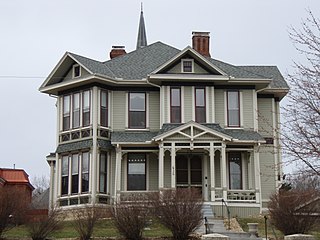
The Star Tribune is the largest newspaper in Minnesota. It originated as the Minneapolis Tribune in 1867 and the competing Minneapolis Daily Star in 1920. During the 1930s and 1940s, the two newspapers were consolidated, with the Tribune published in the morning and the Star in the evening. They merged in 1982, creating the Star and Tribune, which was renamed the Star Tribune in 1987. After a tumultuous period in which the newspaper was sold and re-sold and filed for bankruptcy protection in 2009, it was purchased by local businessman Glen Taylor in 2014.

Frank Beecher Doran (1839—1914) was a Republican politician and the 24th mayor of Saint Paul, Minnesota, holding office between 1896 and 1898.

William Watts Folwell was an educator, writer and historian who was the first president of the University of Minnesota.

William Ellery Channing Whitney was an American architect who practiced in Minneapolis, Minnesota. He specialized primarily in domestic architecture, designing homes for many prominent Twin Cities families.

Thomas H. Van Lear was an American politician who served as the 28th Mayor of Minneapolis from January 1, 1917 to January 6, 1919. Van Lear was a member of the Socialist Party of America.
The Saint Paul Dispatch was a daily newspaper in Saint Paul, Minnesota from 1868 until 1985.

Frederick Gardner Corser was an American architect of homes and public buildings in the U.S. states of Minnesota, North Dakota, and South Dakota, especially in the Minneapolis, Minnesota area.

Harvey Ellis was an American architect, perspective renderer, painter and furniture designer. He worked in Rochester, New York; Utica, New York; St. Paul, Minnesota; Minneapolis, Minnesota; St. Joseph, Missouri; St. Louis, Missouri and Syracuse, New York.

Jakob Henrik Gerhard Fjelde was a Norwegian-born American sculptor. He is remembered as both a prolific portraitist and the creator of public monuments. One of his better known works is the one dedicated to the 1st Minnesota Infantry (1897) located at Gettysburg Battlefield where its 262 members suffered 215 casualties.

Robert W. Gibson, AIA, was an English-born American ecclesiastical architect active in late-nineteenth- and early-twentieth-century New York state. He designed several large Manhattan churches and a number of prominent residences and institutional buildings.

John Francis Wheaton, name alternately written as John Frank Wheaton and J. Frank Wheaton, was an American politician. He was the first African American elected to the Minnesota Legislature, serving in its House of Representatives. Wheaton was known as a vibrant figure and gifted orator who quickly rose to prominence in Minnesota politics only to quickly leave not long afterward.

George W. Orff (1835-1908), was an American architect of Bangor, Maine and Minnesota.

LeRoy Sunderland Buffington (1847–1931) was an American architect from Minnesota who specialized in hotels, public and commercial buildings, churches, and residences. He was born September 22, 1847, in Cincinnati, Ohio. He studied architecture and engineering at the University of Cincinnati and graduated in 1869. He later moved to Saint Paul, becoming a partner of Abraham Radcliffe, and worked on the remodeling of the original Minnesota State Capitol. After the first capitol burned down, Buffington designed a replacement that served as the State House until 1904. In 1881 he claimed to have invented the method of building skyscrapers using load-bearing iron frames. He applied for a patent in November 1887 and received it in May 1888. Even though many subsequent builders used this method of construction, Buffington was mostly unsuccessful in collecting royalties from his patent. Buffington remained in private practice in Minneapolis until his death on February 15, 1931.

Olin Bailey Lewis was an American politician and educator.

Carlos Avery (1868–1930), was an American newspaper publisher and politician in the state of Minnesota. Avery is best remembered as a longtime chief of the Minnesota Game and Fish Commission and was named the first Commissioner of the Game and Fish Commission when that position was created in August 1915. He is the namesake of the Carlos Avery Wildlife Management Area in that state.
The Duluth, Missabe and Northern Railway (DM&N) was a railroad company in the U.S. state of Minnesota. It was one of the earliest iron ore hauling railroads of the area, said to have built the largest iron ore docks in the world, and later was one of the constituent railroads in the merger that formed the Duluth, Missabe and Iron Range Railway.

The 1890 Minnesota Senate election was held in the U.S. state of Minnesota on November 4, 1890, to elect members to the Senate of the 27th and 28th Minnesota Legislatures.















